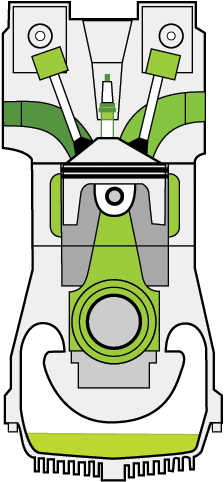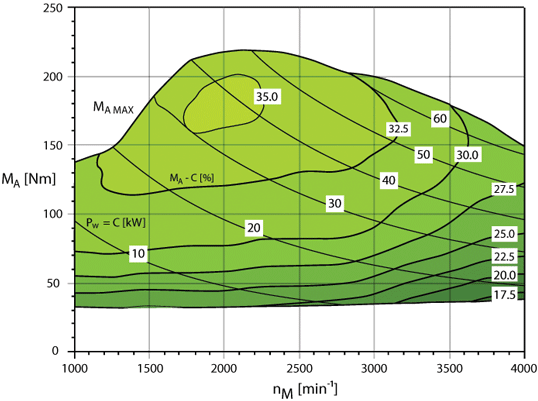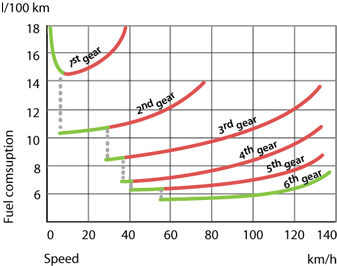Motive force

The driving force is influenced by two main factors:


Use a block heater in winter

The motive force stems from the controlled combustion of the fuel provided to the engine. It is therefore proportional to the amount of fuel injected and engaged by the gas pedal.

The driving force is influenced by two main factors:
| The relationship between the engine speed and the torque |
The engine is more economical in low speed and high torque mode.
Modern engines are designed to be more efficient with a high load. In fact, electronic fuel injections help control the amount of fuel used. This isn’t the case with carburetor engines. For example, a an engine with a high load won’t respond and the speed will slowly increase when going up a steep slope even if you hit the gas pedal hard. Conversely, a non-loaded engine responds instantly when you accelerate and its speed increases quickly.
The chart below illustrates areas where the engine is the most efficient. The engine torque is shown on the ordinate and the engine speed on the abscissa. The light green area represents the highest efficiency while the dark green area represents the highest fuel consumption. You can see that for any given power curb, optimal efficiency is achieved when the engine is in low speed and high torque mode.
Modern engines are designed to be more efficient with a high load. In fact, electronic fuel injections help control the amount of fuel used. This isn’t the case with carburetor engines. For example, a an engine with a high load won’t respond and the speed will slowly increase when going up a steep slope even if you hit the gas pedal hard. Conversely, a non-loaded engine responds instantly when you accelerate and its speed increases quickly.
The chart below illustrates areas where the engine is the most efficient. The engine torque is shown on the ordinate and the engine speed on the abscissa. The light green area represents the highest efficiency while the dark green area represents the highest fuel consumption. You can see that for any given power curb, optimal efficiency is achieved when the engine is in low speed and high torque mode.

| Note: This chart illustrates a vehicle with a small diesel engine. It must therefore be used as a guide, not as a strict rule to follow. For a vehicle with a gas engine, the shape of the chart will shift slightly to the right. |
| The operating temperature |
For its part, the engine temperature must be high enough to optimize its efficiency. When the engine is cold, it consumes more fuel. The best indicator of the engine temperature is the engine coolant temperature.
| How to reduce the motive force? |
1
Drive at the highest possible speed ratio
The best way to maintain the engine in low speed and high torque mode is to select the highest speed ratio. Your engine consumes less fuel in 3rd gear than in 1st gear, and less in 5th gear than in 4th gear.
 |
The chart beside illustrates fuel consumption as a function of speed ratios. You can see that the lower speed ratios are the most gas-guzzling because they are associated with an engine that is not sufficiently loaded. |
| Note: This chart illustrates a vehicle with a small engine. It must therefore be used as a guide, not as a strict rule to follow. |
If you have a manual transmission, go to the highest speed ratio as soon as possible. When you go up a slope, avoid shifting to a lower gear as much as possible to keep your engine loaded. As you approach a stop, shift to a lower gear without braking so as to recover energy over a greater distance.
With an automatic transmission, it is more difficult to control speed ratios but this can be done if you momentarily take your foot off the gas pedal when going up a slope to reach the upper speed ratio.
With an automatic transmission, it is more difficult to control speed ratios but this can be done if you momentarily take your foot off the gas pedal when going up a slope to reach the upper speed ratio.
- If your automatic transmission vehicle has an optional speed ratio, activate it to obtain a higher ratio, which will reduce your speed and fuel consumption.
- On a road with many ground level differences, avoid using the speed regulator to maintain a constant speed, as the gearbox will shift to a lower speed and increase your engine speed when you go up a slope in order to maintain the same speed.
2
Accelerate without hesitation
When accelerating, the decision to increase your speed hinges on your control over the acceleration force. However, the type of acceleration, for example, a slow and progressive acceleration or an excessively fast acceleration, will have an impact on engine efficiency.
The best way to accelerate is to quickly reach the highest possible speed ratio without generating high engine speeds. This technique is more effective than a slow and progressive acceleration as the engine will spend less time working ineffectively.
Nonetheless, this technique must be used at the right time. For example, there is no point in accelerating optimally from an engine efficiency standpoint if you don’t anticipate an upcoming stop and then suddenly have to brake.
The best way to accelerate is to quickly reach the highest possible speed ratio without generating high engine speeds. This technique is more effective than a slow and progressive acceleration as the engine will spend less time working ineffectively.
Nonetheless, this technique must be used at the right time. For example, there is no point in accelerating optimally from an engine efficiency standpoint if you don’t anticipate an upcoming stop and then suddenly have to brake.
3
Use a block heater in winter
During cold weather, connecting a block heater 3 hours before you leave will allow the coolant to quickly reach its optimal temperature and will reduce your fuel consumption for those first few kilometres on the road.
Ref.: Smokers et al. (2006) and Quality Alliance Eco-Drive, Eco-Drive - accélérez intelligemment.
Ref.: Smokers et al. (2006) and Quality Alliance Eco-Drive, Eco-Drive - accélérez intelligemment.











